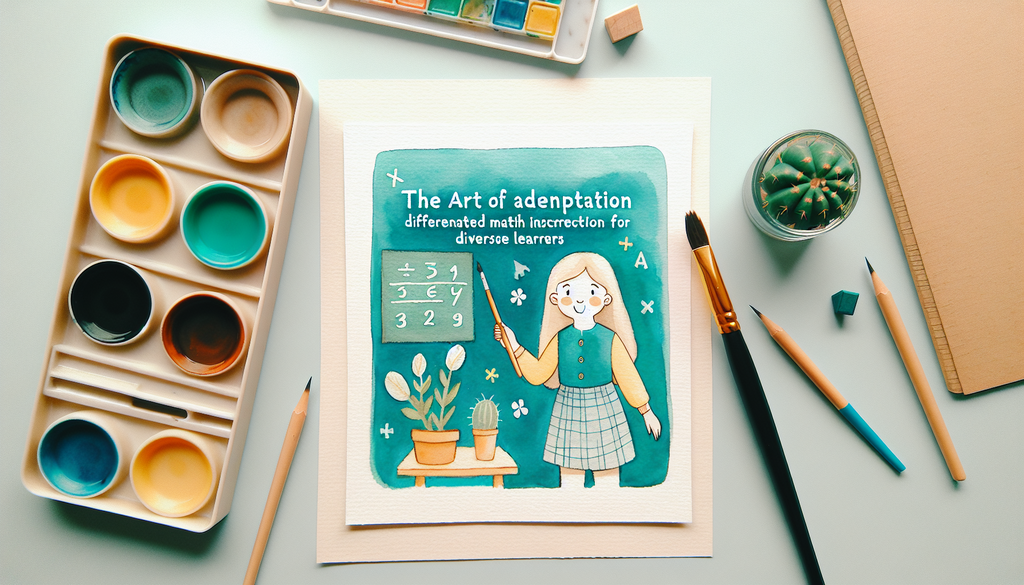The Art of Adaptation: Differentiated Math Instruction for Diverse Learners

We live in an ocean of diversity. Each child brings a unique set of abilities, interests, and ways of learning to the classroom. As parents and educators, our mission is to adapt, foster inclusivity and pave the path of learning in a way that suits every child’s unique abilities. Especially in foundational subjects such as mathematics, it’s vital to implement differentiated instruction strategies that cater to diverse learning styles.
In this post, we’ll explore strategies for differentiated math instruction, aiming to make the learning experience accessible and enjoyable for all students, including those with special needs or identified as gifted and talented.
Understanding Differentiated Instruction
Differentiated instruction is a teaching approach that involves tailoring the teaching process—the content, process, and product—to match individual students’ learning needs and styles. This approach fosters equity in the classroom, as it recognizes and values the diversity among learners and strives to create an environment where every student can thrive.
In Giftedness Across Cultures: Embracing Diverse Talents, we discussed how understanding different cultural frameworks can illuminate the various ways students may approach and understand math. Similarly, the differentiated instruction approach accepts and builds on these varying foundations to create an inclusive learning landscape.
Differentiating Math Instruction
When it comes to math instruction, differentiation can take several forms. Some students may struggle with number sense, while others may excel in abstract mathematical reasoning. Here are some strategies to encompass all abilities in your classroom.
1. Scaffold Instruction
Scaffolding involves breaking down complex tasks into smaller, more manageable steps. This approach is particularly beneficial for students with learning challenges such as dyscalculia. Our post Understanding Dyscalculia: Supporting Children with Math Difficulties provides a deeper understanding of this math learning difficulty and offers supportive strategies.
2. Incorporate Multi-Sensory Techniques
Many children, and especially those with special needs, can benefit significantly from multi-sensory learning. This process combines visual, auditory, kinesthetic, and tactile elements that support students’ understanding in an engaging manner. For children with visual impairments, technology and specialized education materials can make math accessible, as we highlighted in our post on Assistive Devices and Technology for Visual Impairments in Education.
3. Utilize Real-World Applications
Giving math a real-world context can make the subject more engaging and easier to understand for all students. For gifted students, this approach offers an opportunity to see how mathematical theory applies to real-world problems, fostering an inventive mindset.
4. Fuse Technology into Teaching
Integrating technology into the learning process can generate interactive activities for students of all abilities. Teaching platforms, math games, and interactive whiteboard activities allow students to learn at their own pace while having fun. Check out our post on Advancing with Assistive Technology Tools for Special Education for some excellent tech resources.
Collaborative Learning Groups
Another effective differentiation strategy is the use of collaborative learning groups. This approach can be highly beneficial for neurodiverse students, as it provides social interaction and cooperatively solves problems. Refer to our blog post on Navigating Neurodiversity: Celebrating All Kinds of Minds for more insights on creating an inclusive learning environment.
In Conclusion
Differentiated instruction caters to the wide spectrum of students’ skills and needs, creating an inclusive math learning environment that helps all children succeed. By understanding and implementing these strategies, we can ensure that each student’s potential in mathematics—and beyond—is maximized to its full extent.
If you’re looking for more tips like these, we’ve covered many aspects of inclusive education in our other posts. For instance, check out our discussions on Creating Accessible Science Experiments for All Learners and Integrating Life Skills into Special Education Curriculum. As always, we’re here to support you on this rewarding journey of inclusive education.